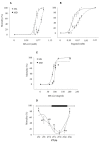Environmental Cycles, Melatonin, and Circadian Control of Stress Response in Fish
- PMID: 31244768
- PMCID: PMC6579845
- DOI: 10.3389/fendo.2019.00279
Environmental Cycles, Melatonin, and Circadian Control of Stress Response in Fish
Abstract
Fish have evolved a biological clock to cope with environmental cycles, so they display circadian rhythms in most physiological functions including stress response. Photoperiodic information is transduced by the pineal organ into a rhythmic secretion of melatonin, which is released into the blood circulation with high concentrations at night and low during the day. The melatonin rhythmic profile is under the control of circadian clocks in most fish (except salmonids), and it is considered as an important output of the circadian system, thus modulating most daily behavioral and physiological rhythms. Lighting conditions (intensity and spectrum) change in the underwater environment and affect fish embryo and larvae development: constant light/darkness or red lights can lead to increased malformations and mortality, whereas blue light usually results in best hatching rates and growth performance in marine fish. Many factors display daily rhythms along the hypothalamus-pituitary-interrenal (HPI) axis that controls stress response in fish, including corticotropin-releasing hormone (Crh) and its binding protein (Crhbp), proopiomelanocortin A and B (Pomca and Pomcb), and plasma cortisol, glucose, and lactate. Many of these circadian rhythms are under the control of endogenous molecular clocks, which consist of self-sustained transcriptional-translational feedback loops involving the cyclic expression of circadian clock genes (clock, bmal, per, and cry) which persists under constant light or darkness. Exposing fish to a stressor can result in altered rhythms of most stress indicators, such as cortisol, glucose, and lactate among others, as well as daily rhythms of most behavioral and physiological functions. In addition, crh and pomca expression profiles can be affected by other factors such as light spectrum, which strongly influence the expression profile of growth-related (igf1a, igf2a) genes. Additionally, the daily cycle of water temperature (warmer at day and cooler at night) is another factor that has to be considered. The response to any acute stressor is not only species dependent, but also depends on the time of the day when the stress occurs: nocturnal species show higher responses when stressed during day time, whereas diurnal fish respond stronger at night. Melatonin administration in fish has sedative effects with a reduction in locomotor activity and cortisol levels, as well as reduced liver glycogen and dopaminergic and serotonergic activities within the hypothalamus. In this paper, we are reviewing the role of environmental cycles and biological clocks on the entrainment of daily rhythms in the HPI axis and stress responses in fish.
Keywords: HPI axis; daily rhythm; fish welfare; light; temperature; thermocycles; wavelength.
Figures




Similar articles
-
Daily rhythms in the hypothalamus-pituitary-interrenal axis and acute stress responses in a teleost flatfish, Solea senegalensis.Chronobiol Int. 2013 May;30(4):530-9. doi: 10.3109/07420528.2012.754448. Epub 2013 Feb 20. Chronobiol Int. 2013. PMID: 23421721
-
Acute stress response in gilthead sea bream (Sparus aurata L.) is time-of-day dependent: Physiological and oxidative stress indicators.Chronobiol Int. 2014 Nov;31(9):1051-61. doi: 10.3109/07420528.2014.945646. Epub 2014 Aug 7. Chronobiol Int. 2014. PMID: 25102424
-
Sensory conflict disrupts circadian rhythms in the sea anemone Nematostella vectensis.Elife. 2023 Apr 6;12:e81084. doi: 10.7554/eLife.81084. Elife. 2023. PMID: 37022138 Free PMC article.
-
Gut clock: implication of circadian rhythms in the gastrointestinal tract.J Physiol Pharmacol. 2011 Apr;62(2):139-50. J Physiol Pharmacol. 2011. PMID: 21673361 Review.
-
Photic and circadian regulations of melatonin rhythms in fishes.Biol Signals. 1997 Jul-Dec;6(4-6):225-32. doi: 10.1159/000109132. Biol Signals. 1997. PMID: 9500660 Review.
Cited by
-
Cortisol as a Stress Indicator in Fish: Sampling Methods, Analytical Techniques, and Organic Pollutant Exposure Assessments.Int J Environ Res Public Health. 2023 Jun 27;20(13):6237. doi: 10.3390/ijerph20136237. Int J Environ Res Public Health. 2023. PMID: 37444085 Free PMC article. Review.
-
Molecular Characterization and Feeding-Associated Expression Dynamics of the Period Gene Family in Channel Catfish (Ictalurus punctatus).Curr Issues Mol Biol. 2025 Jun 9;47(6):438. doi: 10.3390/cimb47060438. Curr Issues Mol Biol. 2025. PMID: 40699837 Free PMC article.
-
Light conditions during Atlantic salmon embryogenesis affect key neuropeptides in the melanocortin system during transition from endogenous to exogenous feeding.Front Behav Neurosci. 2023 Apr 21;17:1162494. doi: 10.3389/fnbeh.2023.1162494. eCollection 2023. Front Behav Neurosci. 2023. PMID: 37153936 Free PMC article.
-
The Effect of Orally Supplemented Melatonin on Larval Performance and Skeletal Deformities in Farmed Gilthead Seabream (Sparus aurata).Int J Mol Sci. 2020 Dec 16;21(24):9597. doi: 10.3390/ijms21249597. Int J Mol Sci. 2020. PMID: 33339403 Free PMC article.
-
Convergent latitudinal erosion of circadian systems in a rapidly diversifying order of fishes.bioRxiv [Preprint]. 2025 May 31:2025.05.28.656707. doi: 10.1101/2025.05.28.656707. bioRxiv. 2025. PMID: 40502044 Free PMC article. Preprint.
References
-
- Zhdanova IV, Reebs SG. Circadian rhythms in fish. Behav Physiol Fish. (2006) 24:197–238. 10.1016/S1546-5098(05)24006-2 - DOI
Publication types
LinkOut - more resources
Full Text Sources

